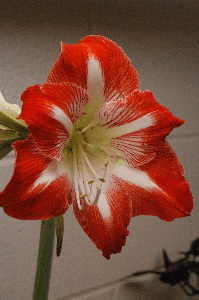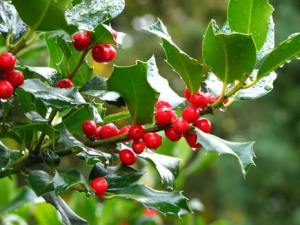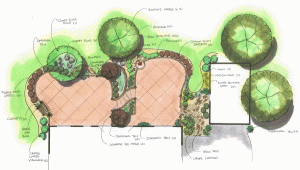These are just a few of the things that our in-house designer can create for your home or business. From small shade gardens to a complete renovation. Click on picture enlarge.
Archive for the ‘Landscaping’ Category
Landscape Design
January 13, 2010New Year’s Top 10
January 5, 2010If you’re like most people, you get busy; work, kids, Church, etc. It happens. This year, this new year, I challenge you to make a list of the things you have been putting off and take advantage of a fresh start. I’m sure your list involves more than outdoor work. In fact, when you start making your To-Do List break it down into parts. For example, start with Indoor, then break it down from there into Rooms. This will make it less overwhelming and you can cross them off your list after you complete it.
How do you eat an elephant….? One bite at a time!
10.) I will build a patio or deck (they’re easier to build than you think).
9.) I will install a water garden (it can be cheaper than you think).
8.) I will have pruning work done on any trees that present a hazard.
7.) I will define my landscape tastes and implement them.
6.) I will grow some plants that will enhance my fall landscape design.
5.) I will provide maximum visual interest for the winter landscape.
4.) I will stop complaining about watering and instead work on improving my water conservation.
3.) I will stop complaining about mowing the lawn and instead explore low-maintenance alternatives to lawns
2.) I will stop complaining about garden pests and take preventive measures against them.
1.) I will fully enjoy my yard, rather than being a slave to its upkeep. I will “stop and smell the roses.”
What would you add to your Outdoor Top 10 Projects of 2010?
Amaryllis Culture
December 4, 2009 The amaryllis is a tender bulb that is ready to bloom when purchased. The genus name for this plant is Hippeastrum, which means “horse star,” an appropriate name for a plant that produces massive blooms as much as 8 to 10 inches across. These plants can produce 3 to 4 blooms on a 1- to 2-foot stem. Often, a second flower stalk follows the first at about the time the flowers on the first stem fade. The leaves usually start to appear when the flowers begin to open.
The amaryllis is a tender bulb that is ready to bloom when purchased. The genus name for this plant is Hippeastrum, which means “horse star,” an appropriate name for a plant that produces massive blooms as much as 8 to 10 inches across. These plants can produce 3 to 4 blooms on a 1- to 2-foot stem. Often, a second flower stalk follows the first at about the time the flowers on the first stem fade. The leaves usually start to appear when the flowers begin to open.
Amaryllis bulbs can be huge – approaching the size of a grapefruit. The larger the bulb, the larger the flowers and the more expensive the bulb. Regardless of size, amaryllis likes tight quarters. Place in a pot only1 to 2 inches larger in diameter than the bulb. About half of the bulb should remain exposed. Hold the bulb so the roots hang down into the pot, and add potting mix. Firm the mix around the roots carefully so that they are not snapped off. Water thoroughly and place the plant in a warm, sunny location. Amaryllis likes day temperatures in the 70s and night temperatures in the 60s. The flower bud may start to appear right away or the plant may remain dormant for a period of time, but eventually all mature bulbs do bloom. Move the plant to a cooler location and out of direct sunlight when the flower buds begin to show color so the flowers last longer. Amaryllis can remain in bloom for about a month.
Flowers should be cut off after blooming to keep the plant from expending energy to form seeds. Place the plant back in a sunny location until it is warm enough to be placed outside. Sink the pot in the soil in an area that has dappled shade. The plant can be gradually moved to sunnier locations until it receives full sun for a half day. Continue to fertilize with a balanced houseplant fertilizer as you would a normal houseplant. Bring the pot in before first frost and place in a dark location. Withhold all water so the leaves have a chance to dry completely. Leaves can then be cut off close to the top of the bulb. Amaryllis can often be left in the same pot for several years but will eventually need repotting. Again, choose a pot that is only 1 to 2 inches larger in diameter than the bulb and repeat the process described above. Offsets are normally produced by amaryllis and can be given their own pots if desired. These small bulbs have a concave side when removed but develop a round shape when given their own space. They grow quickly and can be mature enough to flower in a couple of years.
Protect Your Broadleaf Evergreens
November 19, 2009Fall is upon us, finally, although it seems like it has been here since mid July with the mild summer we had this year. Right now I am sure you are keeping busy with winter bed prep and fall leaf clean up. This is a great time to get a look at landscapes that went in early spring; give some attention to anything that looks tender going in to winter.
A great way to protect a new landscape is to apply Wilt Pruf to broadleaf evergreens: azalea, holly, boxwood, taxus, rhodies. Wilt Pruf will help plants retain moisture when the temperatures dive and sprinkler systems have been shut down. Wilt Pruf is an antidesicant that when sprayed on the plant forms a flexible layer that protects from wind and drought. A good application will last 3-4 months. Wilt Pruf is biodegradable and non-toxic; you do not need a chemical applicators license or any personal protective equipment to apply. Your broadleafs will thank you after the cold, dry winter we had last year.

Begin Rabbit Protection Now
November 17, 2009Rabbits may begin to nibble on newly planted trees and shrubs this time of year. Protect your investment now through this winter with at least 2-foot-tall cylinders of 1-inch-mesh, chicken wire or similar barrier. Other control methods include plastic tree wraps and liquid rabbit repellents sprayed on the plants.
Pruning Shrubs
November 13, 2009Recently, we have received a number of calls from gardeners wanting to cut back shrubs. Though light pruning and/or removal of dead wood is fine this time of year, severe pruning should be left until spring. Keep in mind that even light pruning of spring-blooming shrubs such as lilac and forsythia will reduce flowers for next year. We normally recommend that spring-bloomers be pruned after flowering.
Shrubs differ in how severely they can be cut back. Junipers do not break bud from within the plant and therefore should be trimmed lightly if you wish to keep the full shape. Overgrown junipers should be removed. On the other hand, there are certain shrubs that can be pruned back severely during the spring. Rejuvenation is the most severe type of pruning and may be used on multi-stem shrubs that have become too large with too many old branches to justify saving the younger canes. All stems are cut back to 3- to 5-inch stubs. This works well for spirea, forsythia, pyracantha, ninebark, Russian almond, little leaf mock orange, shrub roses and flowering quince. Just remember that spring is the correct time to do this, not now.
Fall Care of Peonies
November 11, 2009Peony foliage can be cut back to the ground if it hasn’t been already. Foliage may be composted or discarded.
Peonies are fertilized twice a year; in the spring shortly before new growth appears and then again in the fall after the plants have been cut back. A total of 1.5 to 2 ounces of a 1-1-1 fertilizer such as a 10-10-10 or 13-13-13 per plant per application should be used. Therefore, a total of 3 to 4 ounces of fertilizer per year is used. If a soil test reveals adequate levels of phosphorus and potassium, use a high nitrogen fertilizer such as a 16-0-0. You may even use a lawn fertilizer such as a 29-5-4, 27-3-3 or something similar but cut the rate in half.
Never apply fertilizer directly on the center of the peony as the buds (eyes) may be damaged. Rather, place the fertilizer in a band from 8 to 18 inches from the center of the plant. Water the fertilizer in so the plant can take it up.
Winter protection of herbaceous peonies is only necessary the first winter after planting to prevent alternate freezing and thawing from lifting plants out of the soil. A couple of inches of mulch should be sufficient. Any organic material that does not mat down will work (avoid using leaves) and should be applied after the ground freezes. Remove the covering before growth begins in the spring.
The less common tree peonies have woody stems like deciduous shrubs and should not be cut back to the ground or pruned in the fall. Collect the shed leaves and place in the compost pile this fall. Though tree peonies are hardy to Zone 4, they do benefit from a light mulching over winter. Also, it is recommended that tree peonies be fertilized during November to get the plants off to a good start next spring. It is best to take a soil test to see what nutrients are needed. If the soil needs phosphorus and potassium, use a complete fertilizer (such as 10-10-10, 9-9-6, etc.) at the rate of 2.5 pounds per 100 square feet. This would equal 1 rounded teaspoon per square foot. If phosphorus and potassium are not needed, blood meal makes an excellent fertilizer. It should be applied at the rate of 2 pounds per 100 square feet or 1 teaspoon per square foot. Turf fertilizers such as a 27-3-3 or 30-3-3 can also be used, but the rate would have to be cut to 1 pound per 100 square feet or 1 teaspoon per 2 square feet.
Still Time to Plant Spring-Flowering Bulbs
November 11, 2009Generally, it is recommended to plant hardy bulbs (especially daffodils) in October to give them enough time to root before winter. But it is certainly not too late to plant them now. As long as the soil temperatures are above 40 degrees F, the bulbs should continue root development.
Soil temperatures across Missouri and Kansas last week averaged in the 50s and 60s. Although many of the best bulbs have probably already been purchased, garden centers may still have a good selection. Be sure to select large, firm bulbs that have not begun to sprout.
While many bulbs can adapt to a wide range of soil types, none can tolerate poorly drained soil. Prepare the planting bed by adding organic matter such as peat moss, well-rotted manure, or compost. Adequate fertility is essential. It is best to rely on a soil test to determine what nutrients are needed. Garden soils that have been regularly fertilized in the past may have excess levels of phosphorus. Excess phosphorus can interfere with the uptake of other essential micronutrients. In such cases, it would be better to use a fertilizer relatively high in nitrogen such as a 29-5-4, 27-3-3 or something similar. Fertilizers such as the above should be applied at the rate of 2/3 pound per 100 square feet. In the absence of a soil test, or if phosphorus is needed, add a low analysis, balanced fertilizer such as 5-10-5 or 6-10-4 at the rate of 2 to 3 pounds per 100 square feet of bed. Mix all amendments thoroughly with the soil before planting the bulbs.
The size and species of the bulb determines how deep to plant. In general, the depth to the bottom of the bulb should be about 2 to 3 times the size of the bulb, but check the planting instructions specific to each particular flower.




